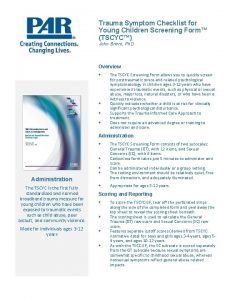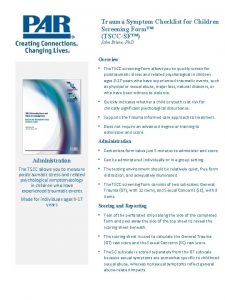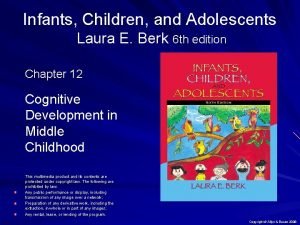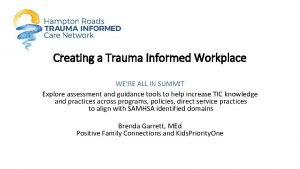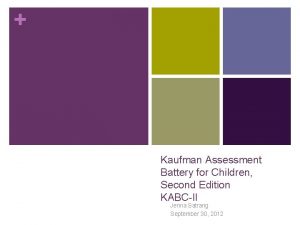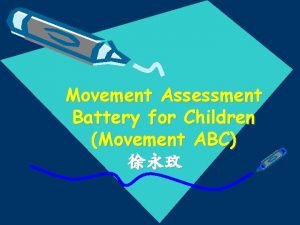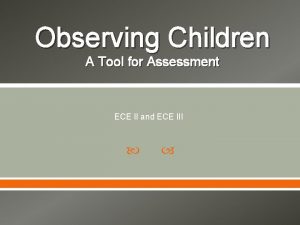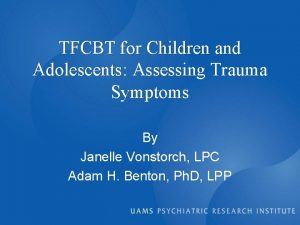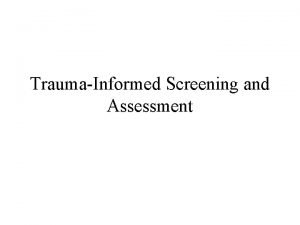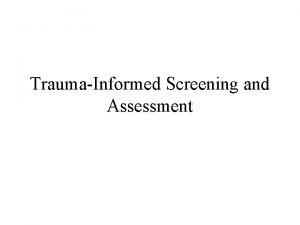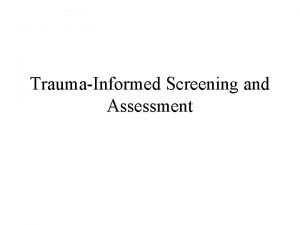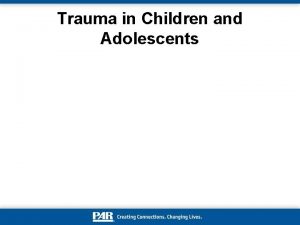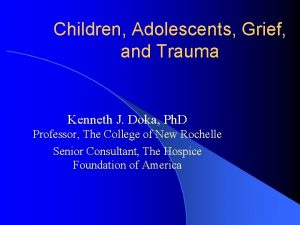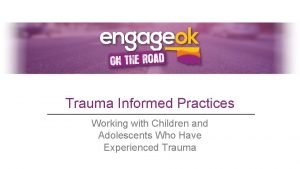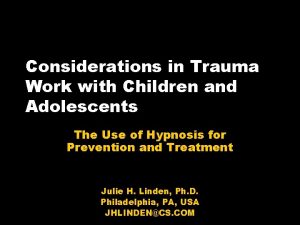Trauma Screening and Assessment for Children and Adolescents












- Slides: 12

Trauma Screening and Assessment for Children and Adolescents Compiled by Ann Jennings, Ph. D.

A Public Health Focus Ø A public health focus on prevention requires identification of trauma exposure in children Ø A “thorough trauma assessment with children and adolescents is a prerequisite to preventing the potentially chronic and severe problems in biopsychosocial functioning that can occur when PTSD and associated or co-morbid behavioral health disorders go undiagnosed and untreated” Wolpaw & Ford 2004

Routine and Universal Ø Questions about trauma should be part of the routine mental health intake of children, with parallel questions posed to the child’s parent or legal guardian Ø Screening and assessment for trauma should occur also in juvenile justice and out-of-home child protection settings as well Ø Assessment for trauma exposure and impact should be a routine part of psychiatric and psychological evaluations, and of all assessments that are face to face. Hodas 2004

Approaches to Assessment of Trauma 3 Basic approaches to assessment of trauma and post-traumatic sequelae in children through tools and instruments: l l l Instruments that directly measure traumatic experiences or reactions Broadly based diagnostic instruments that include PTSD subscales Instruments that assess symptoms not trauma specific but commonly associated symptoms of trauma Wolpaw & Ford 2004

Ø Use of de-escalation preference surveys, a secondary prevention intervention, represents an indirect method of finding out about trauma exposure. E. g. in indicating a desire not to be touched, a child may be reflecting past sexual abuse. NETI, 2003 Ø In institutional settings, use of a risk assessment tool to determine potential contraindications to use of restraint (and other coercive measures) requires that information on past abuse be obtained Hodas 2004

Guidelines Ø Determine if child is still living in a dangerous environment. This must be addressed and stress-related symptoms in the face of real danger may be appropriate and life saving Ø Provide child a genuinely safe setting and inform him/her about the nature, and limitations, of confidentiality Ø Seek multiple perspectives about trauma (e. g. child, parents, legal guardians) Ø Use combination of self-report and assessor-directed questions Ø Recognize potential impact of both culture and developmental level while obtaining trauma information from children. Wolpow & Ford, 2004

Guidelines Ø Because trauma comes in many different forms for children of varying ages, gender, and cultures, there is no simple, universal, highly accurate screening measure. Ø Screening approaches should identify risk factors such as poverty, homelessness, multiple births during adolescence, and other environmental vulnerabilities of trauma-related symptoms and behavior problems associated with trauma histories l l PTSD symptoms (which vary with age) Behavioral symptoms associated with trauma Hodas 2004

Guidelines Ø Parents, guardians or other involved adults would have to participate in screenings of younger children Ø Older children and adolescents could complete a self-report measure Ø Positive screens will require a more comprehensive follow-up evaluation conducted by a professional familiar with manifestations of childhood trauma Hodas 2004

Trauma Screening and Assessment For Trauma Exposure/History: Self-Report and Structured Interview: l A simple screening measure published in JAMA that predicts PTSD in children who were seriously injured in accidents or burned in fires: asks 4 -questions of child, parent, and medical record each. Winston et al 2003 l Childhood Trauma Questionnaire: Bernstein et al, 1994

For PTSD Symptoms: Self-Report and Structured Interviews l l Clinician Administered PTSD Scale for Children and Adolescents. (CAPS-CA): Newman, 2002 UCLA PTSD Reaction Index for Children: Steinberg et al, 2004 l Trauma Symptom Checklist for Children (TSC-C): Anxiety, Depression, Anger, Posttraumatic Stress, Dissociation and Sexual Concerns. Wolpaw et al, in press l PTSD Checklist for Parents (PCL-C/PR) Blanchard et al 1996 l Child Behavioral Checklist (CBCL) General behavioral measures

For Psychosocial and Psychiatric Symptoms: Self-Report and Structured Interview l Diagnostic Interview Schedule for Children (DISC): Shaffer et al 1992 l l Diagnostic Interview for Children and Adolescents. Revised (DICA-R) Reich et al, 1991 Schedule for Affective Disorders and Schizophrenia Present and Lifetime Version, Kiddie version (K-SADSPL) for children and adolescents: Kaufman et al, 1997 For Self-Regulation: Self Report l Parenting Stress Index Short Form (PSI) Abidin, 1995

Validation of Measures Ø The SAMHSA-sponsored National Child Traumatic Stress Network (NCTSN) is well situated to undertake validation of these and other measures across a wide range of age groups, service sectors, cultural settings, and types of trauma. Ø NCTSN is comprised of 50+ centers that provide treatment and services to traumatized children and families in 32 states and DC Ø See www. nctsnet. org
 Tscyc screening form
Tscyc screening form Tscc screening form
Tscc screening form Infants children and adolescents 8th edition
Infants children and adolescents 8th edition Infants, children, and adolescents 8th edition
Infants, children, and adolescents 8th edition Difference between courting and dating
Difference between courting and dating Trauma informed workplace
Trauma informed workplace Kabc-ii score ranges
Kabc-ii score ranges Movement abc-2
Movement abc-2 Observing children a tool for assessment
Observing children a tool for assessment Iso 22301 utbildning
Iso 22301 utbildning Novell typiska drag
Novell typiska drag Nationell inriktning för artificiell intelligens
Nationell inriktning för artificiell intelligens Returpilarna
Returpilarna
